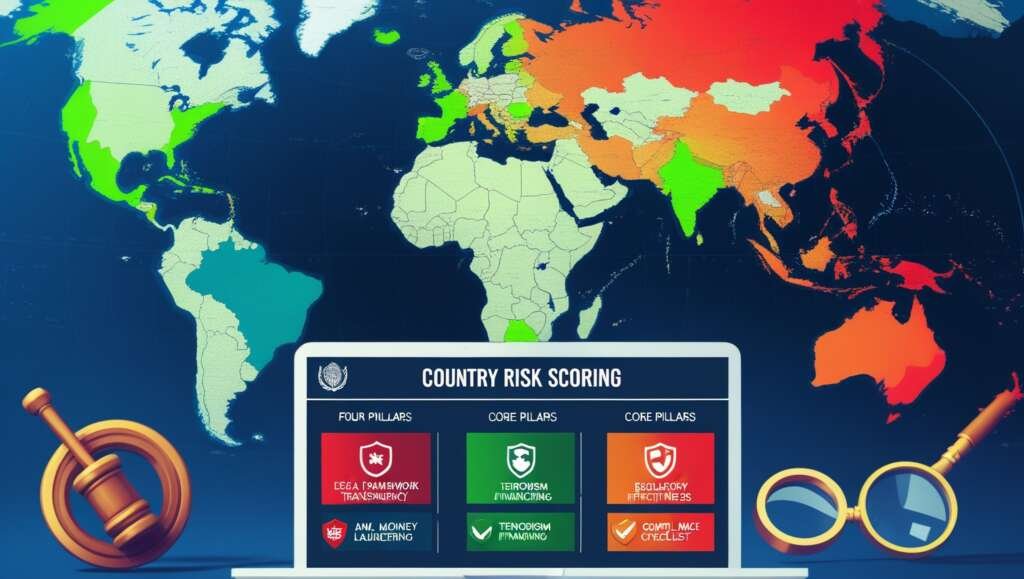In the first part of this series, we explored the foundational pillars of country risk assessment: FATF ratings, the Corruption Perception Index (CPI), international sanctions regimes, and the Basel AML Index. Understanding these key indicators is crucial for any business navigating global financial crime risks. In this second article, we turn theory into practice—introducing a weighted scoring methodology that quantifies risk levels, outlines how to calculate a composite country score, and sets clear thresholds to classify jurisdictions into high, medium, or low-risk categories. Finally, we will discuss the important limitations of such models, emphasizing the need for continuous adaptation and qualitative judgment.
Weighted Scoring Methodology: Quantifying and Prioritizing Risk Factors
To translate these qualitative and quantitative indicators into a practical and actionable country risk scoring model, it is essential to assign weighted scores to each factor. The application of weights is crucial because it allows the model to reflect the perceived impact and criticality of each indicator on the overall AML/CFT risk. A higher weight signifies that a particular indicator has a more significant influence on the final risk score, aligning the model with regulatory expectations and industry best practices regarding risk prioritization.
Proposed Weighting Scheme:
The following weighting scheme is proposed to reflect the relative importance of each risk factor:
- FATF Rating: 40% – This carries the highest weight because FATF is the global standard-setter, and its assessments directly reflect a country’s commitment and effectiveness in combating financial crime. Inclusion on a FATF list (especially the blacklist or greylist) has immediate and significant implications for international financial relations.
- Basel AML Index: 30% – As a composite index, the Basel AML Index provides a holistic view, incorporating multiple data points. Its high weight reflects its comprehensive nature and its ability to capture a broad range of AML/CFT vulnerabilities.
- Sanctions Regimes: 20% – Sanctions represent direct and often legally binding prohibitions or restrictions. Non-compliance carries severe penalties, making this a critical, albeit slightly lower-weighted, factor compared to the broader systemic risks assessed by FATF and Basel.
- Corruption Perception Index (CPI): 10% – While corruption is a strong enabler of money laundering, the CPI is a perception-based index. Its lower weight acknowledges this perceptual aspect while still recognizing its significant contribution to the overall risk profile by indicating governance weaknesses.
Scoring Scale for Each Factor (0-10, where 10 is highest risk):
To ensure consistency and comparability, each factor is mapped to a standardized scoring scale ranging from 0 to 10, where 10 represents the highest level of risk.
- FATF Rating (Weight: 0.4)
- Blacklist: 10 points (e.g., Iran, DPRK) – Represents the absolute highest risk due to severe deficiencies and calls for counter-measures.
- Greylist: 7 points (e.g., countries actively monitored by FATF) – Indicates elevated risk due to ongoing deficiencies, despite commitment to address them.
- Under Review/Other Public Statement: 5 points (countries with specific concerns, but not yet greylisted) – Suggests a notable level of concern that warrants close monitoring.
- Compliant/Largely Compliant: 2 points – Reflects a generally robust framework, but acknowledges that no system is entirely risk-free.
- No Public Concerns: 0 points (countries not on any FATF list, generally considered low risk from an FATF perspective) – Represents the lowest risk from an FATF perspective.
- Basel AML Index (Weight: 0.3)
- Score 8.0 – 10.0: 10 points (Very High Risk) – Countries with the most severe vulnerabilities according to the composite index.
- Score 6.0 – 7.9: 7 points (High Risk) – Indicates significant inherent risks across multiple dimensions.
- Score 4.0 – 5.9: 4 points (Medium Risk) – Suggests moderate vulnerabilities that require careful attention.
- Score 2.0 – 3.9: 2 points (Low Risk) – Represents a generally strong AML/CFT environment.
- Score 0.0 – 1.9: 0 points (Very Low Risk) – Countries with the strongest controls and lowest inherent risks. (Note: The Basel AML Index typically ranges from 0 to 10, so these scores directly map to the index’s scale, making interpretation straightforward.)
- Sanctions Regimes (Weight: 0.2)
- Comprehensive Sanctions (e.g., Cuba, Syria, Russia for certain sectors): 10 points – Indicates broad economic and financial isolation due to severe geopolitical concerns.
- Targeted Sanctions (e.g., specific individuals, entities, or sectors): 7 points – Signals significant, but localized, risks that require precise compliance measures.
- Minor/Limited Sanctions (e.g., very specific individuals/entities, often with limited impact): 4 points – Suggests isolated risks that may not impact broader economic engagement but still require screening.
- No Significant Sanctions: 0 points – Represents the lowest risk from a sanctions perspective.
- Corruption Perception Index (CPI) (Weight: 0.1)
- Score 0 – 20: 10 points (Highly Corrupt, Very High Risk) – Indicates pervasive corruption, undermining governance and AML/CFT efforts.
- Score 21 – 40: 7 points (High Corruption, High Risk) – Suggests significant corruption that creates an enabling environment for illicit finance.
- Score 41 – 60: 4 points (Moderate Corruption, Medium Risk) – Points to noticeable corruption that needs to be factored into risk assessment.
- Score 61 – 80: 2 points (Low Corruption, Low Risk) – Indicates relatively strong governance and lower perceived corruption.
- Score 81 – 100: 0 points (Very Clean, Very Low Risk) – Represents the highest levels of transparency and integrity. (Note: CPI scores range from 0 to 100, where higher is better. Our scoring maps lower CPI scores to higher risk points, aligning with the principle that higher corruption equals higher risk.)
Calculating the Total Country Risk Score: Putting the Pieces Together
The total country risk score is derived by performing a weighted average calculation. This involves multiplying the assigned points for each factor by its respective weight and then summing these weighted scores. The maximum possible score achievable through this methodology is 10 points, which would occur if a country received 10 points across all four indicators (10 * 0.4 + 10 * 0.3 + 10 * 0.2 + 10 * 0.1 = 10). This maximum score represents the highest possible inherent risk.
Formula for Total Risk Score:
Total Risk Score = (FATF Points * 0.4) + (Basel AML Index Points * 0.3) + (Sanctions Points * 0.2) + (CPI Points * 0.1)
Illustrative Example Calculation (Hypothetical Country X):
Let’s apply this formula to a hypothetical “Country X” to demonstrate the calculation:
- FATF Rating: Country X is on the FATF Greylist, which translates to 7 points.
- Basel AML Index: Country X has a Basel AML Index score of 6.5. According to our scoring scale, this maps to 7 points.
- Sanctions Regimes: Country X is subject to Targeted Sanctions, resulting in 7 points.
- CPI: Country X has a CPI score of 35, which maps to 7 points (indicating high corruption).
Now, let’s plug these values into the formula:
Total Risk Score = (7 * 0.4) + (7 * 0.3) + (7 * 0.2) + (7 * 0.1) = 2.8 (from FATF) + 2.1 (from Basel AML Index) + 1.4 (from Sanctions) + 0.7 (from CPI) = 7.0
In this hypothetical example, Country X receives a total risk score of 7.0. This score will then be used to categorize Country X into one of the predefined jurisdictional risk thresholds, determining the level of due diligence required.
Defining Jurisdictional Risk Thresholds: Guiding Due Diligence Intensity
Once the total country risk score is calculated, the next crucial step is to categorize countries into clear jurisdictional risk levels. These categories are fundamental because they directly dictate the intensity and nature of the due diligence measures that businesses must apply to customers and transactions associated with that country. This tiered approach ensures that resources are allocated efficiently, with greater scrutiny applied where the risks are highest.
-
High Risk (Score > 6.5):
- Implication: Jurisdictions falling into this category present a significant and elevated risk of money laundering, terrorist financing, or other serious financial crimes. This high risk typically stems from a combination of factors: they may possess demonstrably weak AML/CFT controls, exhibit high levels of systemic corruption, or be subject to extensive and comprehensive international sanctions. Operating in or with these jurisdictions carries substantial legal, financial, and reputational risks.
- Due Diligence: For customers and transactions originating from or destined for these countries, Enhanced Due Diligence (EDD) is not merely recommended but mandatory. EDD involves a significantly deeper level of scrutiny than standard procedures. This includes, but is not limited to, conducting more extensive background checks on individuals and entities, rigorously verifying the source of wealth and source of funds, implementing intensified and continuous transaction monitoring, and requiring higher-level approvals for account opening or transaction execution. The aim is to gain a profound understanding of the customer’s activities and the underlying purpose of transactions to mitigate the heightened risks.
- Examples: Countries that are consistently on the FATF Blacklist, those frequently appearing on the FATF Greylist with persistently high Basel AML Index scores, and/or those subject to broad, comprehensive international sanctions.
-
Medium Risk (Score 3.5 – 6.5):
- Implication: These jurisdictions pose a moderate level of inherent risk. While they might exhibit some vulnerabilities in their AML/CFT frameworks or be subject to specific, targeted concerns (e.g., certain types of financial crime or political instability), they are generally seen as actively working towards strengthening their regulatory and enforcement capabilities. They are not considered as immediate or pervasive a threat as high-risk countries.
- Due Diligence: For these jurisdictions, Standard Due Diligence (SDD) is the baseline requirement. However, businesses must maintain a heightened awareness and be prepared to escalate to Enhanced Due Diligence (EDD) if any additional red flags emerge during the customer onboarding process, throughout the ongoing customer relationship, or during transaction monitoring. Robust ongoing monitoring should be a standard practice to detect any deviations from expected behavior or changes in the risk profile.
- Examples: Countries that might be on the lower end of the FATF Greylist, or those with moderate Basel AML Index scores and perhaps some targeted sanctions that do not broadly impact the economy.
-
Low Risk (Score < 3.5):
- Implication: Jurisdictions categorized as low risk are generally considered stable, possessing robust and well-implemented AML/CFT controls, low levels of perceived corruption, and minimal or no exposure to significant international sanctions. They are seen as having a strong commitment to financial integrity and a low likelihood of being exploited for illicit financial activities.
- Due Diligence: Typically, these countries permit the application of Simplified Due Diligence (SDD). This involves focusing on basic identity verification and ongoing monitoring, with less intensive data collection and verification requirements. However, it is crucial to remember that even for low-risk countries, the underlying principle of a risk-based approach still applies. This means that any unusual activity, unexpected transaction patterns, or the emergence of new red flags would immediately trigger a higher level of scrutiny, potentially escalating to SDD or even EDD. The goal is always to remain vigilant and adaptable.
- Examples: Countries with consistently strong FATF compliance ratings, very low Basel AML Index scores, and high CPI scores, indicating high transparency and low corruption.
Limitations of the Model: Acknowledging Complexity
While this weighted scoring model offers a structured, quantifiable, and seemingly objective approach to country risk assessment, it is imperative to acknowledge its inherent nuances and limitations. No single model can perfectly capture the intricate and dynamic nature of global financial crime risks. Recognizing these limitations ensures that the model is used as a powerful tool within a broader, more flexible risk management framework, rather than as an infallible oracle.
- Simplified Representation of Complex Realities: The model gives a simple score to show how risky a country is when it comes to money laundering and terrorist financing. It looks at several big issues and turns them into numbers. This is helpful for making quick decisions, but it doesn’t show every small detail or new risk. It gives a snapshot based on past and public information, but the real world is always changing.
- Qualitative Assessment Remains Paramount:
Even a smart scoring system needs human judgment. A trained compliance officer who follows the news, understands the region, and knows the company’s business is still very important. For example, a country may look safe based on the numbers, but if new scams are happening there, the officer’s opinion should matter more than the score. For instance, a country might have a seemingly “good” overall score, but if recent news indicates a sudden surge in a particular type of financial crime relevant to a business’s operations (e.g., a new crypto scam originating from that country), the qualitative assessment should override or significantly influence the quantitative score, triggering heightened scrutiny. The model provides a starting point, not the final word.
- Dynamic Nature of Risk: Country risk is not static; it is constantly evolving. FATF lists are updated periodically, sanctions regimes can change rapidly in response to geopolitical events, and CPI scores are refreshed annually. Organizations must establish robust processes to ensure their risk scoring models are regularly reviewed and updated to reflect the absolute latest information. This necessitates real-time monitoring of geopolitical developments, regulatory announcements, and global financial crime trends. A model based on outdated data is a dangerous model.
- Data Availability and Accuracy Challenges: The effectiveness and reliability of this model are directly contingent upon the availability of accurate, timely, and comprehensive data for each indicator. In some less transparent jurisdictions, obtaining reliable data for CPI or even detailed FATF implementation reports can be challenging, potentially leading to inaccuracies in the scoring. Businesses often rely on third-party data providers for this information, and the quality of that data is paramount.
- Business-Specific Context is Crucial: The inherent risk posed by a country is not universal; it can vary significantly based on the specific products, services, and customer types that a business offers. For example, a Virtual Asset Service Provider (VASP) dealing with high-value, cross-border crypto transfers might perceive a country with moderate AML controls as significantly higher risk than a traditional bank offering purely domestic retail services in the same country. The VASP’s exposure to new technologies, cross-border flows, and potentially less regulated counter-parties fundamentally alters its risk appetite and assessment. Therefore, the model should be adaptable to incorporate business-specific risk factors and appetites.
- Sub-national Risk and Geographic Nuances: This model primarily focuses on national-level risk. However, it’s important to recognize that risk can also vary significantly within a country. Certain regions, provinces, or even specific economic zones within a nation might pose higher threats due to localized corruption, organized crime, or specific illicit activities. While a national score provides a broad overview, businesses operating with a high degree of granularity may need to supplement this with sub-national risk assessments.
A Strategic Imperative for Financial Integrity
In an era defined by increasingly sophisticated financial crime and heightened regulatory expectations, developing and implementing a robust country risk scoring framework is no longer merely a best practice; it has become an undeniable strategic imperative for businesses navigating the complexities of global Anti-Money Laundering and Counter-Financing of Terrorism compliance. By systematically applying weighted scores to key international indicators—such as the authoritative FATF ratings, the insightful Corruption Perception Index, the critical international sanctions regimes, and the comprehensive Basel AML Index—organizations are empowered to establish clear, actionable thresholds for high, medium, and low jurisdictional risk categories.
This structured, data-driven approach offers multifaceted benefits. It not only significantly enhances the efficiency and consistency of due diligence processes across diverse customer bases and transaction types, but it also provides a transparent and defensible methodology for demonstrating unwavering compliance to national and international regulators. While quantitative models like the one outlined here offer a strong, objective foundation for risk assessment, their true power is unlocked when they are continuously refined, enriched by qualitative insights, and dynamically adapted to the ever-changing landscape of global financial crime. Embracing such a smart, proactive, and adaptable framework is absolutely crucial for safeguarding financial integrity, mitigating severe penalties, and ensuring the sustainable and responsible operation of businesses within a highly regulated and interconnected global economy. The future of financial services hinges on this commitment to intelligent risk management. In a world where financial crime is constantly evolving, standing still is not an option. The question is: will your compliance framework be ready for what’s next—or will it be left behind?




